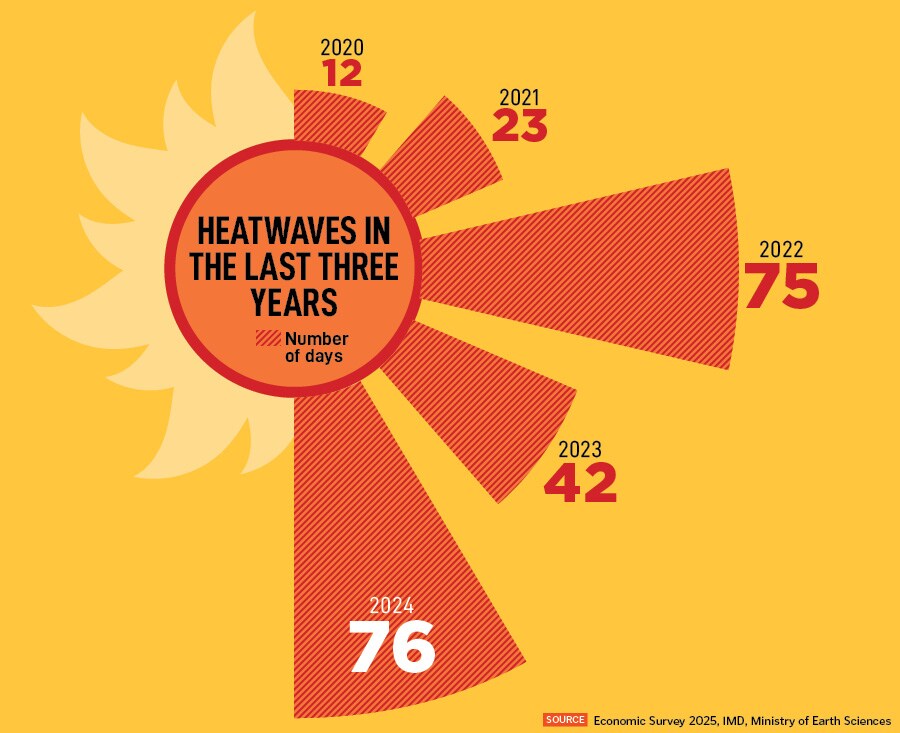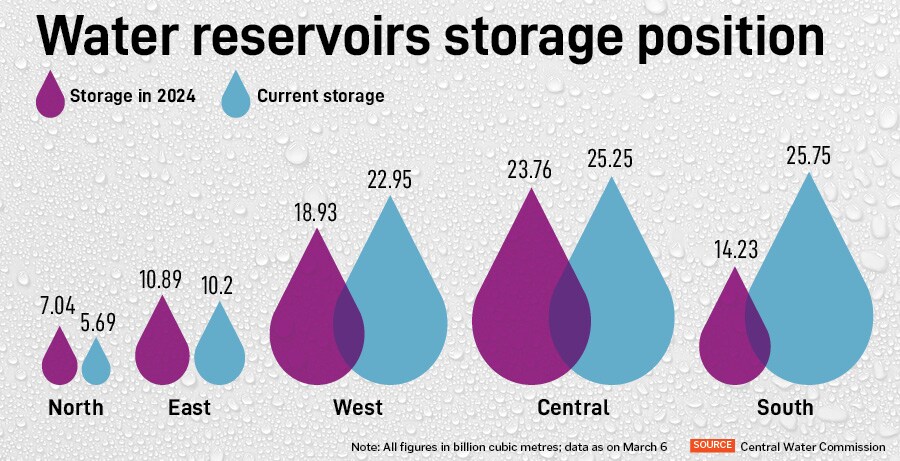Crop yields and prices are sharply affected by severe heat and constant fluctuations in temperature. Last February was the hottest and driest month in India in 125 years, according to the IMD. It forecasts that from March to May, above-normal number of heatwave days are expected over most parts of the country except the Northeast India, extreme North India and southwestern and southern parts of Peninsular India.
“Above-normal temperatures and potential heatwaves in some parts of the country over the next few months could hasten the seasonal rise in vegetable prices that is typically seen between March and July, and hence are key monitorables," says Aditi Nayar, chief economist, head research and outreach, ICRA.
She explains that while summer sowing has progressed well so far, excessive heat could impact yields and affect the output, although summer crops account for a small share in overall crop output.
In the past two years, the Indian economy has gone through multiple episodes of heatwaves and excessive rains, which have impacted the food supply chains and prices. The Economic Survey 2024-25 says India experienced heatwaves on 18 percent of days, on an average, during 2022-2024, compared to 5 percent in 2020 and 2021. Total crop area damaged in 2024 was higher compared to the last two years due to extreme weather events.
![]()
In fact, total crop area damaged in 2024 was higher compared to the last two years due to extreme weather events, shows data published by the Centre for Science and Environment (CSE) and Down to Earth (DTE). The country experienced extreme weather events on 93 percent of the days in the first nine months of 2024. Weather events such as heat and coldwaves, cyclones, lightning, heavy rain, floods and landslides killed 3,238 people and affected 3.2 million hectares of crop area, according to the data.
According to Radhika Rao, senior economist, DBS Group Research, a simple correlation between food inflation and observed annual average mean surface air temperature stands at 0.7 in the five years to 2023 and when time horizon is extended to the past decade, the correlation drops.
“The risk is more acute for the rabi (winter) crop, impacting not only prices of cereals but also horticulture production," Rao explains.
For instance, 70 percent of the annual onion production occurs during the rabi season, with Maharashtra accounting for 41 percent of total output in 2022-23, followed by Madhya Pradesh at 16 percent.
Besides output, volatile weather/high temperatures also impact storage and transportation. A major share of potato harvest is also concentrated in the rabi months, with Uttar Pradesh and West Bengal accounting for more than half of the total output, according to a Reserve Bank of India (RBI) working paper. While onions’ shelf life can be extended in a right dehumidified environment, tomatoes have short crop cycles, production is concentrated in a few states (Madhya Pradesh, Andhra Pradesh, Karnataka etc and have a shorter shelf life. About two-third of its production also occurs in the rabi season.
Food prices, inflation & monsoon
Latest food inflation of February declined to a 21-month low at 3.8 percent from 5.7 percent in the month-ago period due to sequential fall in vegetables, pulses and eggs prices. However, economists caution that once rising temperature sets in, food prices are likely to be impacted.
Rahul Bajoria, head of India and ASEAN Economic Research, Bank of America, feels a drop in food inflation is likely to start stabilising in March, as the prices of potatoes and tomatoes hit their historical lows, and other vegetable prices start to find a stable footing, as supply fades and summer heat starts to impact production.
Others concur. For March, the comfort from winter seasonality is seen waning, amidst an early onset of summer, says Yuvika Singhal, economist, QuantEco Research. This accompanied by an upward revision to milk prices by local players, as well concerns of standing wheat crop shrivelling, could push March CPI (or retail) inflation above 4 percent, she adds. The RBI projects inflation at 4.2 percent for FY26.
Singhal expects broad comfort on food prices to continue into FY26, with food inflation trajectory gradually descending lower, as lagged benefits from a strong 2024-25 foodgrain production continue to manifest.
“CPI inflation outlook depends largely on the performance of Southwest monsoon in 2025. While these are early days yet, global weather agencies expect ENSO neutral conditions to prevail over the coming summer months. This should prove to be neutral for India’s monsoon season," she says. Assuming a normal and evenly distributed monsoon season, Singhal expects disinflationary momentum to prevail in FY26.
![]()
Currently, weak La Nià±a conditions are prevailing over the equatorial Pacific, and the sea surface temperatures (SSTs) are cooler than normal over most of the equatorial Pacific Ocean, says the IMD. The latest IMD/MoES Monsoon Mission Climate Forecast System forecast indicates that La Nià±a conditions are likely to weaken during the upcoming season and turn to neutral ENSO conditions thereafter.
La Nià±a conditions refer to events when trade winds are even stronger than usual, pushing more warm water toward Asia.
According to analysts at Nomura, daily data so far in March suggest food prices are rising, led by vegetables, fruits and meat and fish—partly on seasonality but they expect lower prices for pulses and eggs and a moderate increase for milk. “India is experiencing early signs of a heatwave (expected to last until May), which, if it materialises, could pose a risk to the rabi crop output. Meanwhile, weak domestic demand and deflation in manufacturing input costs should keep core inflation subdued," they say.
However, Nomura economists feel beyond March, the combination of a robust crop output and the government’s sensitivity to price flare-ups should lead to lower food inflation this year.
Currently, overall storage position in reservoirs in India is better than the corresponding period last year in the country as a whole and is also better than the normal storage during the corresponding period, according to the Central Water Commission (CWC). There are 150 reservoirs that are monitored by the CWC on a weekly basis. The total live capacity at full reservoir level is around 180 billion cubic metres.
Impact on consumption
Nayar also warns that severe heatwaves could impact retail footfalls and hurt the travel segment, which would have a bearing on consumption demand. “This could pose some downside risks to our GDP growth estimates for Q4FY25 and Q FY26," she says.
She expects rural demand to remain upbeat in the near term, aided by the robust growth in crop output in FY25, and the farm cash flows on account of the rabi harvest starting from March 2025.
There was a sequential improvement in India’s GDP growth to 6.2 percent in the October to December quarter of FY25 led by a pickup in the growth of private and government consumption and a narrower drag on account of net exports.
While festival season-related demand would have contributed to the acceleration sequentially (compared with the slump seen in Q3), rural demand also likely drove overall growth as evidenced through high-frequency indicators of two-wheeler sales and FMCG companies" sales, says Barclays in its analysis. However, it had said that with above-normal rainfall in the monsoon season, and strong production as per advance estimates of kharif production (harvests typically starting from late October onwards), a robust number (agriculture GVA) was expected. Agriculture GVA growth accelerated to 5.6 percent in Q3FY25.
Meanwhile, analysts at Mirae Mutual Fund expect rural economy to see a pickup led by a healthy rabi season. “As a result, corporate earnings should bottom out over the next one to two quarters," they say. Corporate earnings have been lagging in the last few quarters due to multiple factors, including limping consumption demand.


